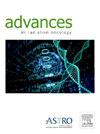Ultra–Low-Dose Radiation for Extranodal Marginal Zone Lymphoma of the Lung
IF 2.2
Q3 ONCOLOGY
引用次数: 0
Abstract
Purpose
Definitive intent radiation therapy (RT) for early-stage mucosa-associated lymphoid tissue (MALT) lymphoma typically includes a dose of 24 to 30 Gy. While modest, these doses may have associated toxicity. For patients with indolent B-cell lymphoma, there is increasing support for the use of ultra–low-dose RT (ULDRT) using 4 Gy in 2 fractions as part of a response-adapted approach, as high rates of complete response have been documented. This paradigm has been prospectively evaluated in the management of orbital and gastric indolent B-cell lymphomas; however, there is limited data guiding the use of ULDRT for lung MALT.
Methods
We conducted a retrospective review of 20 patients at our institution with lung MALT treated with ULDRT as part of a response-adapted approach. Clinical variables including prior systemic therapy and symptoms were abstracted from the electronic health record. Responses were assessed using the revised Lugano criteria.
Results
At a median follow up of 17 months following 4 Gy (IQR, 8-37 months), we observed 100% local control. Nineteen patients (95%) experienced a complete response. No patients with stage IE disease at RT (17/20; 85%) experienced distant progression. Nine patients (45%) were symptomatic prior to RT, with improvement or resolution of symptoms in 7 (7/9; 78%). One patient developed grade 2 pleuritic pain following RT, which resolved with a brief course of steroids. No other toxicities were noted.
Conclusions
ULDRT, given in a response-adapted approach, is effective and well tolerated by patients with lung MALT.
超低剂量放射治疗肺外边缘区淋巴瘤
目的早期粘膜相关淋巴组织(MALT)淋巴瘤的明确意向放射治疗(RT)通常包括 24 至 30 Gy 的剂量。这些剂量虽然不大,但可能会产生相关毒性。对于轻度 B 细胞淋巴瘤患者,越来越多的人支持使用超低剂量 RT(ULDRT),将 4 Gy 分 2 次注射,作为反应适应疗法的一部分,因为完全反应率很高。这种模式已在眼眶淋巴瘤和胃轻度B细胞淋巴瘤的治疗中进行了前瞻性评估;然而,指导超低剂量RT用于肺部MALT的数据却很有限。方法:我们对本机构20例接受超低剂量RT治疗的肺部MALT患者进行了回顾性研究,作为反应适应方法的一部分。临床变量包括既往接受过的系统治疗和症状,均从电子病历中提取。结果在4 Gy治疗后中位随访17个月(IQR,8-37个月),我们观察到100%的局部控制。19名患者(95%)获得了完全缓解。接受 RT 治疗时处于 IE 期的患者(17/20;85%)均未出现远处进展。九名患者(45%)在接受 RT 治疗前出现症状,其中七名患者(7/9;78%)的症状得到改善或缓解。一名患者在 RT 治疗后出现 2 级胸膜炎性疼痛,经过短暂的类固醇治疗后缓解。结论肺MALT患者采用反应适应型ULDRT治疗有效且耐受性良好。
本文章由计算机程序翻译,如有差异,请以英文原文为准。
求助全文
约1分钟内获得全文
求助全文
来源期刊

Advances in Radiation Oncology
Medicine-Radiology, Nuclear Medicine and Imaging
CiteScore
4.60
自引率
4.30%
发文量
208
审稿时长
98 days
期刊介绍:
The purpose of Advances is to provide information for clinicians who use radiation therapy by publishing: Clinical trial reports and reanalyses. Basic science original reports. Manuscripts examining health services research, comparative and cost effectiveness research, and systematic reviews. Case reports documenting unusual problems and solutions. High quality multi and single institutional series, as well as other novel retrospective hypothesis generating series. Timely critical reviews on important topics in radiation oncology, such as side effects. Articles reporting the natural history of disease and patterns of failure, particularly as they relate to treatment volume delineation. Articles on safety and quality in radiation therapy. Essays on clinical experience. Articles on practice transformation in radiation oncology, in particular: Aspects of health policy that may impact the future practice of radiation oncology. How information technology, such as data analytics and systems innovations, will change radiation oncology practice. Articles on imaging as they relate to radiation therapy treatment.
 求助内容:
求助内容: 应助结果提醒方式:
应助结果提醒方式:


